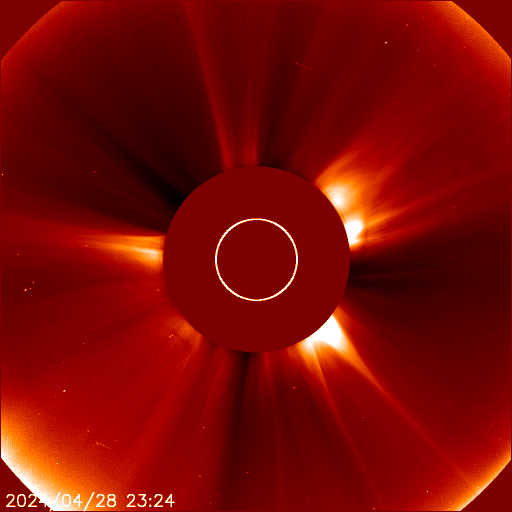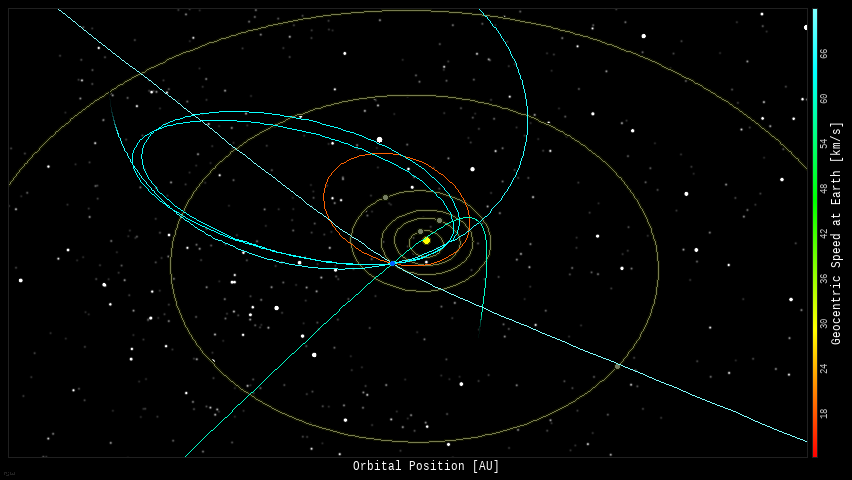Mars Helicopter Flies a Fourth Time!
After a hiccup, the Ingenuity rovercraft has flown a fourth time in Mars’ thin atmosphere – rising to 5 meters, flying south and returning for a round trip of 266 meters.
The fifth flight will have Ingenuity go on a one-way mission, landing at a new site. If Ingenuity remains healthy, the next demonstration phase will begin. The helicopter can attempt to perform aerial observations of rover science targets, image potential rover routes, view inaccessible features, and capture stereo images for digital elevation maps.
Something that was mentioned during the Warren Astronomical Society meeting last night is the possibility that dust may collect on the solar panels, and Ingenuity might not survive being immobile for the couple of weeks when Mars is at solar conjunction during the fall, and radio communications with all Mars spacecraft is impossible.

Jupiter and Saturn appear in the southeastern predawn sky all week; the waning crescent Moon appears in conjunction with Jupiter on May 4th and 5th.
-

Southeastern predawn sky on May 4th. Credit: Bob Trembley / Stellarium. -

Southeastern predawn sky on May 5th. Credit: Bob Trembley / Stellarium.
Mars appears above the constellation Orion in the western sky after sunset.

At midnight, the constellations Lyra and Hercules appear in the eastern sky.

I was wondering where Mercury and Venus were, so I turned off the atmosphere in Stellarium – they’re right there at sunset – completely lost in the glare of the Sun.


The Moon is a Waning Crescent – visible low to the east before sunrise.
The New Moon occurs on May 11th.

If you click on the Moon image above, or click this link, you will go to NASA’s Moon Phase and Libration, 2021 page – it will show you what the Moon looks like right now. If you click the image on that page, you will download a high-rez TIFF image annotated with the names of prominent features – helpful for logging your lunar observations!
Moon News:

The Earth-facing side of the Sun has been spot-free for 2 days; there is an active sunspot on the far side of the Sun that blew-out a CME on May 2-3.
Two intense regions of coronal loop activity are rotating out of view, while another rotates into view. Both the northern and southern coronal holes are medium-large sized, and there are several small coronal holes peppering the Sun’s face. There are also multiple… I don’t know what to call them… coronal pathways, maybe… snaking across the Sun’s face. I can’t recall seeing anything like this before!
Several large prominences on the Sun’s limb, and a days-long filament stretching across the southern hemisphere.
You can view the Sun in near real-time, in multiple frequencies here: SDO-The Sun Now.
You can create your own time-lapse movies of the Sun here: AIA/HMI Browse Data.
You can browse all the SDO images of the Sun from 2010 to the present here: Browse SDO archive.
Solar Activity on Facebook – Run by Volunteer NASA/JPL Solar System Ambassador Pamela Shivak

Solar Corona
Solar wind speed is 427.8 km/sec, with a density of 3.3 protons/cm3 at 1205 UT.
Near real-time animation of the corona and solar wind from the Solar & Heliospheric Observatory (SOHO):

Sun News:

- Near-Earth Objects (NEOs) discovered this month: 14, this year: 839 (+77), all time: 25,630 (+78)
- Potentially hazardous asteroids: 2179 (-3) (updated 2021-05-04)
- Total Minor Planets discovered (NASA): 1,079,625 (+3829)
- Total Minor Planets discovered (MPC): 1,069,907 (updated 2021-04-27)
Upcoming Earth-asteroid encounters:
| Asteroid | Date(UT) | Miss Distance | Velocity (km/s) | Diameter (m) |
| 2021 AF8 | 2021-May-04 | 8.8 LD | 9.4 | 344 |
| 2021 HC3 | 2021-May-04 | 18.6 LD | 25.3 | 181 |
| 2018 JP | 2021-May-05 | 10.7 LD | 7.8 | 12 |
| 2021 JE | 2021-May-06 | 17.7 LD | 8.2 | 25 |
| 2021 AE4 | 2021-May-06 | 18.5 LD | 9.1 | 153 |
| 2021 HF1 | 2021-May-07 | 12.4 LD | 2.8 | 10 |
| 2021 GM10 | 2021-May-10 | 12.7 LD | 5.8 | 38 |
| 2021 GK1 | 2021-May-11 | 1.5 LD | 2 | 14 |
| 2021 JC | 2021-May-12 | 13.7 LD | 11.3 | 33 |
| 2021 JD | 2021-May-12 | 16.6 LD | 2.9 | 18 |
| 2015 KJ19 | 2021-May-14 | 15.1 LD | 23 | 118 |
| 478784 | 2021-May-18 | 15.8 LD | 5 | 27 |
| 2021 HJ2 | 2021-May-22 | 16.1 LD | 8.2 | 68 |
| 2021 FN4 | 2021-May-24 | 6.1 LD | 8.3 | 85 |
| 2021 HD3 | 2021-May-25 | 12.1 LD | 7.9 | 48 |
| 2013 VO11 | 2021-May-25 | 3.5 LD | 10.2 | 8 |
| 2018 LB | 2021-Jun-01 | 2.9 LD | 7.7 | 22 |
| 441987 | 2021-Jun-25 | 15.6 LD | 13.4 | 189 |
| 2021 GM4 | 2021-Jul-01 | 12.1 LD | 6.3 | 151 |
Asteroid News:

On May 3, 2021, the NASA All Sky Fireball Network reported 7 fireballs!
(5 sporadics, 2 eta Aquarids)

Fireball News:
If you see a bright meteor or a fireball, please REPORT IT to the American Meteor Society and the International Meteor Organization!

Position of the planets & several spacecraft in the inner solar system on May 4th.

Position of the planets in the middle solar system:

Position of the planets, and a several transneptunian objects in the outer solar system.

Solar System News:

See a list of current NASA missions here: https://www.jpl.nasa.gov/missions/?type=current

ex·o·plan·et /ˈeksōˌplanət/, noun: a planet orbiting a star other than the Sun.
Data from the NASA Exoplanet Archive
* Confirmed Planets Discovered by TESS refers to the number planets that have been published in the refereed astronomical literature.
* TESS Project Candidates refers to the total number of transit-like events that appear to be astrophysical in origin, including false positives as identified by the TESS Project.
* TESS Project Candidates Yet To Be Confirmed refers to the number of TESS Project Candidates that have not yet been dispositioned as a Confirmed Planet or False Positive.
Exoplanet News
Visit NASA’s Eyes on Exoplanets site and explore exoplanets in 3D: https://eyes.nasa.gov/apps/exo/#/

This image was featured on Spaceweather.com on April 4th:
“BLACK AURORAS OVER SCOTLAND: Red. Green. Purple. These are the colors we usually see during any display of auroras. On April 18th, Alan C. Tough of Hopeman, Moray, Scotland saw something else. “Black,” he says. In the photo below, “note the dark vertical strip above the green band, which is devoid of any normal auroral colour.”
Black auroras have been seen before. They are dark rings or black blobs that sometimes appear in an otherwise ordinary expanse of auroral light. Some researchers call them “anti-auroras.” The black auroras in Tough’s photo are circled here.
Ordinary auroras are caused by electrons raining down from space, hitting Earth’s upper atmosphere and making the air glow. Black auroras are the opposite. Instead of electrons raining down, electrons are propelled upward, back into space.”
SpaceWeather.com Realtime Aurora Gallery: https://spaceweathergallery.com/aurora_gallery.html

Visit an International Dark Sky Park: https://www.darksky.org/our-work/conservation/idsp/parks/
If you live in Michigan, visit the Michigan Dark Skies site: https://sites.lsa.umich.edu/darkskies/

Hubble – Beautiful Universe: HH 24 (May the 4th!)

Credits: NASA/ESA
When stars form within giant clouds of cool molecular hydrogen, some of the surrounding material collapses under gravity to form a rotating, flattened disk encircling the newborn star.
Though planets will later congeal in the disk, at this early stage the protostar is feeding on the disk with a Jabba-like appetite. Gas from the disk rains down onto the protostar and engorges it. Superheated material spills away and is shot outward from the star in opposite directions along an uncluttered escape route — the star’s rotation axis.
Shock fronts develop along the jets and heat the surrounding gas to thousands of degrees Fahrenheit. The jets collide with the surrounding gas and dust and clear vast spaces, like a stream of water plowing into a hill of sand. The shock fronts form tangled, knotted clumps of nebulosity and are collectively known as Herbig-Haro (HH) objects. The prominent HH object shown in this image is HH 24.
Just to the right of the cloaked star, a couple of bright points are young stars peeking through and showing off their own faint lightsabers — including one that has bored a tunnel through the cloud towards the upper-right side of the picture.
Stay safe, be well, and look up!
Software Apps used for this post:
NASA Eyes on the Solar System: an immersive 3D solar system and space mission simulator – free for the PC /MAC. I maintain the unofficial NASA Eyes Facebook page.
SpaceEngine: a free 3D Universe Simulator for Windows. Steam version with VR support available.
Stellarium: a free open source planetarium app for PC/MAC/Linux. It’s a great tool for planning observing sessions. A web-based version of Stellarium is also available.


